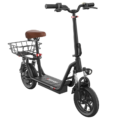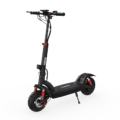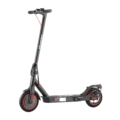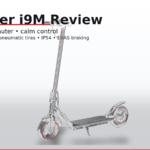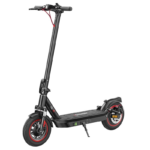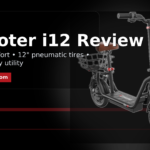- Home
- Scooters
- Electric Scooters
- iScooter i10 Max
iScooter i10 Max


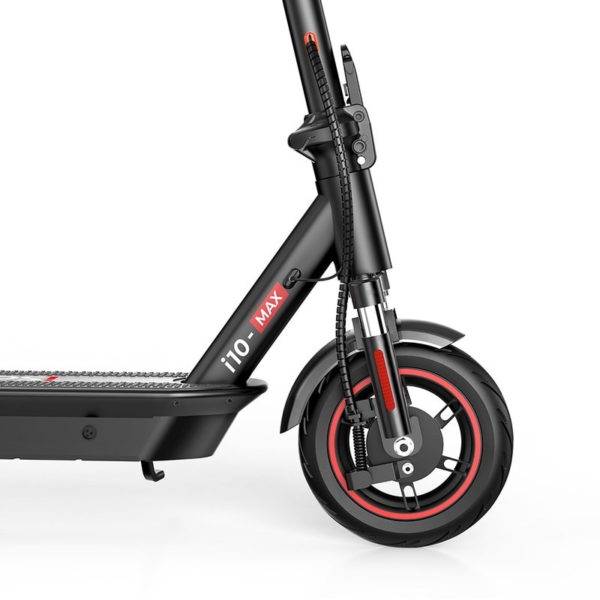

- Battery Range: 50–60 miles (80–96 km)
- Top Speed: 28 mph (45 km/h)
- Motor Power: 750 W rear hub
- Weight Capacity: 264 lb (120 kg)
- Charging Time: ~8–9 h
- Scooter Weight: 46.7 lb (21.2 kg)
PROS
- Large 48 V 15.6 Ah battery
- RWD traction with EBAS assist
- Front & rear suspension comfort
- 10″ pneumatics for grip/feel
- IP54 splash resistance
CONS
- Longest charge time in the series
- Heavier than i10/i10 Plus
- Range varies with speed/temp
- Air tires need pressure checks

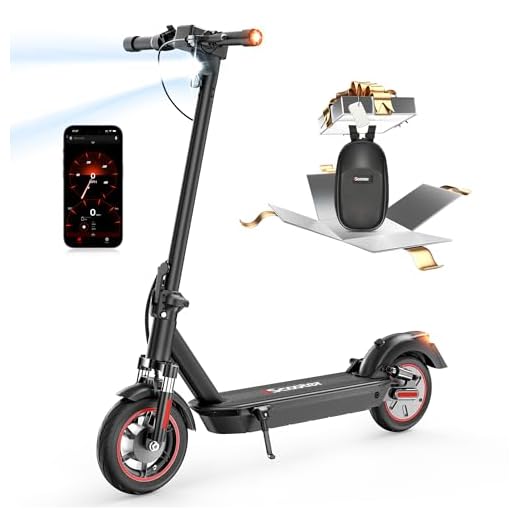
Table of contents
- What Is the iScooter i10 Max?
- How the iScooter i10 Max Works
- Key Specifications
- Design & Build Quality
- Performance Fundamentals
- Battery, Range & Efficiency
- Ride Quality & Comfort
- Braking & Safety Features
- Portability & Daily Usability
- Maintenance & Care
- Weather & Seasonal Considerations
- iScooter i10 Max vs Alternatives
- Who the iScooter i10 Max Is (and Isn’t) For
- FAQs
- Glossary
- Design & Build Notes, Explained
- Practical Range Scenarios
- Safety Habits That Pay Off
- Why the iScooter i10 Max Works for Daily Commuting
- A Note on Specifications and Real-World Use
- Wrap-Up
The iScooter i10 Max is a commuter-class electric scooter designed for riders who want practical range, solid power, and day-to-day durability. It targets city streets, campus paths, and mixed suburban routes. Thanks to a 48-volt system, a 750-watt rear hub motor, and 10-inch pneumatic tires, it offers confident cruising without overwhelming beginners. Because it sticks to official specifications and keeps features sensible, it suits first-time owners as well as riders upgrading from entry-level models.
What Is the iScooter i10 Max?
In short, it’s a foldable, mid-weight adult scooter built around a 48 V battery, a rear-wheel hub motor, and a steel/aluminum architecture that prioritizes reliability over flash. It uses 10-inch air-filled tires for a smoother ride and includes dual suspension to mute rough pavement. Moreover, it pairs a rear disc brake with an electronic brake for predictable stopping. As a result, you get a commuter that balances speed, range, and control rather than chasing extreme numbers.
You’ll find a multi-function LED display, a thumb throttle, and a dedicated brake lever on the handlebar. Additionally, the scooter includes integrated front and rear LEDs, reflectors, and turn indicators for visibility. It folds down for storage, and the folding latch doubles as a hook when you carry it by the stem. Because the deck is long and flat, most riders can place both feet comfortably in a snowboard-style stance.
How the iScooter i10 Max Works
Every electric scooter combines five core systems: the motor, controller, battery, throttle, and brakes. The iScooter i10 Max keeps each of those simple and easy to understand.
Motor. A 750 W rear hub motor sits inside the back wheel. Since it’s direct-drive, it applies torque smoothly. You’ll feel a steady push from the first twist of the thumb throttle. Rear-wheel drive also improves traction under acceleration, especially on dusty pavement or mild inclines.
Controller. The controller is the scooter’s “brain.” It meters battery power to the motor based on your throttle input and the selected speed mode. Consequently, it shapes both acceleration and efficiency. Because it’s integrated, you don’t manage it directly; however, you’ll notice its behavior in how the scooter ramps up speed and holds a cruise.
Battery. A 48 V, 15.6 Ah pack supplies energy. Voltage influences top-speed potential and motor punch, while amp-hours relate to capacity. Multiply them and you get watt-hours—roughly 748 Wh here—which is a practical figure for comparing range across scooters.
Throttle. The i10 Max uses a thumb-press throttle. It sits under your right thumb and allows fine control at low speeds. This is helpful when threading through pedestrians or holding 10–12 mph (16–19 km/h) on crowded bike paths.
Brakes. You get a rear mechanical disc plus electronic braking (often called EBAS) that applies motor resistance. The lever feel is firmer than a pure cable brake because the controller also contributes slowing force. Consequently, you’ll notice consistent deceleration once the lever passes the halfway point.
Key Specifications
All values below reflect official data with both US and metric units for clarity.
| Category | Item | Value |
|---|---|---|
| General | Model | iScooter i10 Max |
| Drive | Rear-wheel drive | |
| Speed Modes | 4 modes | |
| App | iScooter App (iOS/Android) | |
| Recommended Age | 14+ years | |
| Performance & Power | Motor | 750 W rear hub |
| Top Speed | 28 mph (45 km/h) | |
| Max Slope | 15% grade | |
| Throttle | Thumb press | |
| Battery, Charging & Electrical | Battery | 48 V, 15.6 Ah (≈ 748 Wh) |
| Max Charging Voltage | 54.6 V | |
| Charger Output | 54.6 V, 2 A | |
| Charging Time | 8–9 hours | |
| Build & Dimensions | Unfolded (L×W×H) | 46.8 × 20.8 × 48.8 in (117 × 53 × 124 cm) |
| Folded (L×W×H) | 46.8 × 20.8 × 21.6 in (117 × 53 × 55 cm) | |
| Net Weight | 46.7 lb (21.2 kg) | |
| Tires | 10-in (25.4 cm) pneumatic | |
| Suspension | Front and rear shocks | |
| Safety & Control | Brakes | Rear disc + electronic braking (EBAS) |
| IP Rating | IP54 | |
| Max Load | 264 lb (120 kg) | |
| Lights | Front LED, rear LED, reflectors | |
| Turn Signals | Integrated indicators | |
| Features & Extras | Display | Multi-functional LED display |
| Cruise Control | Yes | |
| Handlebar | Non-folding, fixed height, foam grips | |
| Mudguards | Integrated fenders | |
| Warranty & Compliance | Warranty | 12 months (manufacturer) |
| Operating Temperature | 32–104 °F (0–40 °C) | |
| Charger Input | 100–240 V AC | |
| Note | Local riding laws and speed limits vary by region |
Design & Build Quality
The i10 Max favors a practical, commuter-first design. The stem is sturdy and locks with a latch that you can adjust with a small screw to remove play. Because the handlebars are fixed-height, there’s one less joint to loosen over time. The grips are foam, which reduces buzz from rough asphalt and stays comfortable on longer rides.
The deck is long enough for staggered foot placement and wide enough to keep your stance stable at cruise. As a result, you can ride for several miles without constantly shifting. The charging port sits high on the deck sidewall under a rubber cap, which helps prevent splash ingress. The included kickstand holds the scooter securely, and the rear fender is robust enough to hook during folding without feeling flimsy.
Fit and finish are what you’d expect in this class. Cables are routed cleanly along the stem, and the display sits centered with good visibility in daylight. The turn indicators are integrated, not clip-on parts, which keeps the cockpit tidy. Additionally, the folding hinge is reinforced by a safety catch to reduce accidental releases.
Performance Fundamentals
Acceleration. In Sport mode, the i10 Max spins up briskly from a stop, yet it doesn’t surge. The controller applies power smoothly, so the first few feet feel controlled, not jumpy. Consequently, new riders learn throttle finesse quickly. In lower modes, launch is gentler, which helps in crowded spaces.
Cruising stability. The 10-inch pneumatic tires and dual suspension absorb chip-seal vibration and small cracks. Therefore, the scooter tracks straight at speed, provided tire pressures are set correctly. We recommend checking PSI weekly. Because the deck sits at a practical height, you maintain a low center of gravity that helps stability on quick lane changes.
Hill behavior. On typical city grades around 7–10%, the 750 W motor keeps momentum, although speed will naturally drop as the slope increases. If you approach a hill at 12–15 mph (19–24 km/h), it will crest steadily in Sport mode. On steeper or longer climbs, plan a lower gear—meaning a slower speed mode—and give the motor time to work rather than pinning the throttle.
Battery, Range & Efficiency
The 48 V, 15.6 Ah pack stores roughly 748 Wh of energy. Voltage supports the scooter’s 28 mph (45 km/h) ceiling, while capacity dictates endurance. Officially, the range is “up to 50 miles (80 km).” That figure assumes a relatively light rider, moderate temperatures, flat terrain, and conservative speeds. In practice, your results will vary, and that’s expected.
What affects range most? Rider weight, speed, wind, elevation, temperature, and tire pressure all influence energy use. Higher speeds ramp up aerodynamic drag, so cruising at 15–18 mph (24–29 km/h) uses far less power than riding at the limit. Additionally, cold weather reduces available capacity, and under-inflated tires increase rolling resistance. Because each variable matters, treat the “up to” range as a best-case scenario.
Charging. The included 54.6 V, 2 A charger recharges the pack in about 8–9 hours from low. As a rule, avoid storing the scooter at 0%. Instead, put it away between 40% and 80% for long breaks. Because lithium-ion prefers a moderate state of charge, this habit prolongs useful life. Also, allow the scooter to dry fully after a wet ride before charging, and never charge in direct sun or below freezing.
Efficiency tips. Use a lower speed mode for crowded routes, keep tires at the recommended PSI, and accelerate progressively rather than hammering the throttle. These small choices extend range without hurting commute times.
Ride Quality & Comfort
Ride comfort depends on three things: tires, suspension, and ergonomics. The i10 Max checks each box in a balanced way.
Tires. Ten-inch pneumatic tires have two key benefits. First, they add a cushion of air that softens edges and chatter. Second, they maintain grip on rough surfaces because they conform to imperfections. Even so, keep an eye on pressure. Under-inflation fails early in turns, and over-inflation feels skittish.
Suspension. Front and rear shocks take the sting out of pothole rims and curb cuts. They’re tuned for commuting rather than off-road hits. As a result, you get comfort on harsh asphalt without excessive bobbing during acceleration or braking.
Ergonomics. The thumb throttle reduces wrist fatigue at cruise. Meanwhile, the brake lever has a defined bite point halfway through the pull, then it ramps up firmly. Because the deck is flat and long, most riders can shift weight comfortably in turns and stay planted at 20+ mph (32+ km/h). Stem flex is minimal for the class, especially with the latch tightened properly, which further supports confidence.
Braking & Safety Features
The braking system combines a rear mechanical disc with electronic braking on the front motor circuit. Pull the lever lightly and you’ll feel mild regen slowing; squeeze deeper and the disc bites with more authority. This blend keeps stops smooth in traffic yet strong when you need a quick scrub of speed. Practice on an empty street so your hands learn the lever’s progression.
For visibility, the scooter includes a forward LED headlight, a rear LED with brake illumination, reflectors, and integrated turn indicators. Use them. Signaling helps drivers and cyclists understand your intentions, especially at dusk. The IP54 rating means it resists dust and splashes, although it is not meant for submersion or pressure-washers. Because electronics hate standing water, avoid deep puddles and store the scooter indoors.
Portability & Daily Usability
At 46.7 lb (21.2 kg), the i10 Max sits in the portable-but-not-ultralight camp. You can carry it for a flight of stairs, yet you won’t want to hold it for long. Fortunately, the folded package is compact: 46.8 × 20.8 × 21.6 in (117 × 53 × 55 cm). It fits in most car trunks and under many office desks. The latch hooks to the rear fender during folding, so it stays closed while you lift from the stem.
Day to day, the display is clear, the throttle is predictable, and the cruise control reduces hand fatigue on long straight paths. Because the scooter includes 4 speed modes, you can match performance to context: lower for crowded promenades, higher for open bike lanes. For security, carry a quality lock and fasten through the stem or frame to a fixed object. Additionally, bring the charger to work if your round-trip pushes into the upper portion of the range.
Maintenance & Care
Electric scooters run with less maintenance than bicycles, yet a routine prevents small issues from growing. Here’s a simple schedule you can follow.
Before every ride (30 seconds).
- Check tire pressure with a gauge.
- Squeeze the brake lever to confirm strong, even feel.
- Ensure the latch is fully closed and the safety catch is seated.
- Verify lights and indicators work.
Weekly.
- Inspect tires for cuts and embedded debris.
- Wipe the deck and stem with a damp cloth, avoiding high-pressure sprays.
- Check for play in the folding hinge; tighten the adjustment screw if needed.
Monthly.
- Inspect rotor and pads; adjust cable slack to keep the bite point consistent.
- Look over fasteners on the stem clamp, brake caliper, and fender.
- Open the rubber charge-port cover and make sure it seals cleanly.
- Test cruise control and all speed modes to confirm normal controller behavior.
Seasonally.
- Deep-clean the scooter and apply a light protectant to metal hardware.
- Update the companion app if prompted and review any available firmware notes.
- Check for cracks in reflectors, the headlight lens, and the taillight housing.
Battery habits.
- Store between 40–80% if you won’t ride for a few weeks.
- Charge after wet rides only once the scooter is dry and at room temperature.
- Avoid full discharges; lithium-ion prefers shallow cycles for longevity.
Weather & Seasonal Considerations
Rain. With an IP54 rating, the i10 Max shrugs off splashes and light rain; however, it’s not waterproof. Ride more slowly because wet braking distances grow. Avoid paint lines, metal plates, and standing water, since those surfaces get slick. Afterward, dry the scooter, especially around the brake rotor, caliper, and charge port.
Heat. High temperatures thin brake pad resins and warm the battery. Give the scooter breaks on long hill climbs, and avoid charging in direct sun. Because tires expand as air warms, recheck PSI after the scooter sits in a hot trunk.
Cold. Range drops in cold weather due to chemistry. Therefore, expect fewer miles at 40 °F (4 °C) than at 70 °F (21 °C). Start with a warm battery if possible, and keep speeds moderate to conserve energy. Additionally, check the deck for moisture when you bring the scooter inside; condensation sometimes forms as temperatures change.
iScooter i10 Max vs Alternatives
Electric scooters fall into loose categories. The i10 Max sits in the commuter segment. It isn’t a featherweight last-mile scooter that you carry everywhere, and it isn’t a dual-motor off-road machine. Instead, it aims for a practical middle ground. If you’re considering a step-up within the same family, you might also compare the iScooter i10 Pro.
Against lightweight commuters. The i10 Max offers more range, larger tires, and stronger acceleration. It feels steadier above 15 mph (24 km/h) and more forgiving on broken pavement. However, it weighs more, so hopping up multiple flights of stairs is harder.
Against performance scooters. It’s more approachable. Acceleration is smooth rather than explosive, and maintenance is simpler with a single motor and a single mechanical disc brake. On the other hand, absolute top-end speed and steep-grade climbing will favor bigger, heavier machines.
Against off-road-focused models. The i10 Max rides better on city streets. Pneumatic tires and dual suspension handle potholes gracefully, yet the geometry and tires are tuned for asphalt, not trails. If you need knobby tires and very long travel, consider a true off-road design. Otherwise, the i10 Max covers daily duty well.
Who the iScooter i10 Max Is (and Isn’t) For
Great for:
- Urban commuters covering 5–20 miles (8–32 km) per day.
- Students who want a stable, approachable ride with solid bump absorption.
- Multi-modal travelers who fold the scooter for train or car legs.
- Riders who value integrated lights, indicators, and a usable app more than exotic features.
Not ideal for:
- Riders who must carry a scooter up several flights every day.
- Speed chasers who expect sport-bike acceleration.
- Trail explorers who need off-road tires and long-travel suspension.
Choose the iScooter i10 Max if you want a balanced commuter with strong fundamentals. Skip it if weight or extreme power is your top priority.
FAQs
1) Does the iScooter i10 Max fit taller riders?
Yes, many taller riders are comfortable because the deck is long and the cockpit is uncluttered. However, the fixed-height handlebar means you can’t raise the stem, so very tall riders should test stance and reach.
2) How far can I ride on one charge?
Officially, up to 50 miles (80 km). Real-world range depends on speed, weight, terrain, and temperature. Reduce cruising speed and maintain tire pressure to stretch distance.
3) Can I ride in the rain?
The IP54 rating protects against splashes. You can ride in light rain with caution, but avoid heavy downpours, deep puddles, and washing with a hose. Always dry the scooter before charging.
4) What is the top speed, and is it adjustable?
The top speed is 28 mph (45 km/h) in its highest mode. You can select lower speed modes for shared paths, which is safer and more efficient.
5) How does the braking system feel?
It blends electronic braking with a rear disc. Light lever pulls engage gentle regen; deeper pulls add firm mechanical bite. Practice progressive squeezes for smooth stops.
6) Where can I read an “iScooter i10 Max overview” without digging through forums?
You’re reading it now. This article gathers the essentials in one place and explains how the systems work in plain language.
7) What are the key maintenance steps?
Check tire pressure weekly, inspect pads and rotor monthly, tighten the folding latch as needed, and store the battery at a moderate state of charge. These habits keep performance consistent.
Glossary
- Ah (Amp-hours): Battery capacity; higher Ah means more stored energy at a given voltage.
- Wh (Watt-hours): Total energy; roughly voltage × amp-hours. It’s the best single number for range comparisons.
- Voltage (V): Electrical “pressure.” Higher voltage helps support higher speeds and stronger acceleration.
- Controller: The scooter’s power manager that regulates current to the motor based on throttle position and mode.
- Regen (Regenerative Braking): Motor-based braking that turns momentum into a small amount of electrical energy while slowing the wheel.
- Disc Brake: Mechanical brake using a caliper and rotor; provides consistent stopping power.
- EBAS / Electronic Brake: Electronic braking that uses the motor to slow the scooter; pairs with the mechanical brake for smoother stops.
- Pneumatic Tire: Air-filled tire that cushions bumps and improves grip over rough surfaces.
- Stem Flex: Slight bending of the steering column under load; less flex usually means a more stable feel.
- IP Rating: Ingress Protection code; IP54 means dust-resistant and protected against water splashes.
- Grade / Slope: The steepness of a hill, often expressed as a percentage.
- Thumb Throttle: A lever under the thumb that controls speed; allows fine low-speed adjustments.
- Speed Modes: Preset power levels that change acceleration and top speed.
- Cruise Control: A feature that holds a steady speed so you can relax your throttle hand.
- Watt (W): Unit of motor power; more watts generally mean stronger acceleration and better hill performance.
Design & Build Notes, Explained
Because good commuting depends on predictability, the i10 Max favors stable geometry and clear control feedback. The stem latch closes with an audible click, and the safety catch provides a second check. If you feel any play after months of use, you can tighten the adjustment screw a quarter-turn at a time until the movement disappears. This basic design decision keeps steering precise.
The deck’s grip keeps shoes planted in wet and dry conditions. However, wipe it clean after rainy rides so mud doesn’t wear the surface. The mudguards block wheel spray well at commuting speeds, which keeps water off your back and reduces grit on the deck.
Finally, the cockpit layout is simple. The display shows mode, speed, and battery level at a glance. Because the throttle is thumb-driven, it won’t twist accidentally when you push the scooter by hand, which reduces awkward starts around bike racks.
Practical Range Scenarios
To make range expectations realistic, consider three common cases.
Case A: Flat city, moderate pace.
A 165 lb (75 kg) rider cruising at 15–18 mph (24–29 km/h) on mostly flat pavement can complete a multi-stop commute with battery to spare. Smooth throttle inputs and proper PSI help a lot.
Case B: Hilly suburb, mixed speeds.
On rolling terrain with 7–10% hills, expect slower climbing in the last third of the battery. Use a lower mode on ascents, then recover on flats. Plan mid-day charging if your route is long.
Case C: Cold morning starts.
At 40 °F (4 °C), range may drop noticeably. Start with a battery that spent the night indoors, and keep speeds conservative until the pack warms from use.
These scenarios illustrate why “up to” numbers are only a starting point. Your habits and route matter.
Safety Habits That Pay Off
Good habits prevent most mishaps. Always pre-ride check: tire pressure, latch, brakes, and lights. Roll off slowly until you know surface grip. Because electronic braking feels different from pure mechanical systems, practice a few stops in a safe area. Look, signal, and scan—visibility and communication keep you out of trouble.
Helmet use is strongly advised. Even at modest city speeds, a fall can injure. Gloves improve grip and protect hands. At night, reflective bands on your backpack or jacket make you far more visible from the side.
Why the iScooter i10 Max Works for Daily Commuting
Commuters need a scooter that “just works.” The i10 Max focuses on the fundamentals: a steady frame, punchy yet manageable power, a battery sized for real routes, and comfort features that don’t require tinkering. Because it uses pneumatic tires and dual suspension, you can ride longer without fatigue. Since it includes cruise control and multiple speed modes, your hands relax on longer paths. And because the braking system mixes electronic and mechanical force, stops feel progressive rather than abrupt.
Additionally, the official specifications include folded measurements, which matter more than catalog photos. The package fits easily in most trunks and under many office tables. That practicality is often the difference between riding daily and leaving a scooter in the garage.
A Note on Specifications and Real-World Use
Numbers describe potential; habits unlock results. The i10 Max’s 28 mph (45 km/h) ceiling doesn’t mean you must ride at the limit. In dense areas, lower modes keep you safer and extend range. Similarly, the 50-mile (80 km) maximum range assumes ideal conditions. Treat it as a top-end benchmark, then customize your expectations to your route, weather, and speed.
If you weigh near the 264 lb (120 kg) load rating, inflate tires toward the upper end of the recommended PSI, inspect the brake pads more frequently, and rehearse emergency stops in a quiet lot. These small steps keep performance consistent over time.
Wrap-Up
The iScooter i10 Max is a well-rounded commuter scooter with real-world range, stable manners, and a straightforward feature set. It’s powerful enough to handle typical city hills yet friendly for new riders. It folds easily, carries acceptably for short distances, and includes the lighting and indicators that daily riders need. If you want a stable, approachable machine for urban miles, this model deserves a close look.
Specifications
General
| Model The Model specifies the exact version or name of the scooter. It helps identify its unique design, features, and specifications within the manufacturer’s product line. Knowing the model makes it easier to compare options, find compatible accessories, or look up support information. | i10 Max |
| Brand The Brand identifies the manufacturer or company that designs and produces the scooter. A trusted brand is a sign of quality, reliability, and good customer support. Well-known brands often have higher standards for safety, performance, and after-sales service, giving you more confidence in your purchase. | iScooter |
| Release Date The Release Date indicates when the scooter model was officially launched on the market. This helps you know how current the design, technology, and features are. A newer release date often means updated components, improved performance, and the latest safety or smart features. | 17 November 2025 |
| Recommended Age Recommended Age indicates the minimum age range that the scooter is designed for, based on safety, size, and ease of use. Following the recommended age helps ensure that riders can handle the scooter’s speed, weight, and controls comfortably and safely. Always check local laws and use protective gear, especially for younger riders. | Recommended 14+ |
Performance & Power
| Motor Power (Wattage) What it means: The motor power, measured in watts (W), shows how strong the scooter’s electric motor is. Why it matters: Higher wattage usually means better acceleration, more torque, and improved performance on hills or rough terrain. For example, a 250W motor is good for flat city roads and light riders, while a 500W or 1000W motor provides more power for faster speeds or climbing steep inclines. | 750 W rear hub motor |
| Top Speed The Top Speed indicates the maximum speed that the scooter can reach under optimal conditions. It’s usually measured on level ground with a fully charged battery and an average rider weight. A higher top speed allows you to travel longer distances faster, but always ensure you ride within legal speed limits and your personal comfort zone for safety. | 28 mph (45 km/h) |
| Battery Capacity Battery Capacity refers to the total amount of energy the scooter’s battery can store, usually measured in ampere-hours (Ah) or watt-hours (Wh). A higher battery capacity means you can ride longer distances on a single charge, reducing the need for frequent recharging. Keep in mind that actual range can vary depending on rider weight, terrain, speed, and weather conditions. | 48 V 15.6 Ah |
| Estimated Range per Charge The Estimated Range per Charge indicates the average distance the scooter can travel on a single full battery charge. This range is calculated under optimal conditions, such as flat terrain, moderate speed, and average rider weight. Real-world range may vary depending on riding style, terrain, weather, and load. A longer range means fewer recharges and greater freedom for longer trips. | 50–60 miles (80–96 km) |
| Hill Climb Ability Hill Climb Ability describes the maximum incline or slope that the scooter can handle while maintaining stable performance. It’s typically expressed as a percentage or in degrees. A higher hill climb rating means the scooter can tackle steeper hills without losing too much speed or power. Actual climbing performance may vary based on rider weight, battery charge, and terrain conditions. | Not specified |
| Drive System The Drive System refers to how power from the motor is delivered to the wheels. Electric scooters typically use either a hub motor (directly integrated into the wheel) or a chain/belt drive system. A high-quality drive system ensures smooth acceleration, efficient power transfer, and low maintenance. The choice of drive system affects performance, noise level, and overall ride experience. | Rear wheel drive (RWD) |
Charging & Electrical
| Charging Time Charging Time indicates how long it takes to fully recharge the scooter’s battery from empty to 100% using the standard charger provided. Faster charging means less downtime and more time on the road. Actual charging time may vary slightly depending on battery capacity, charger output, and environmental conditions. | Approx. 8–9 hours |
| Battery Type Battery Type refers to the specific technology used in the scooter’s battery, which affects performance, lifespan, weight, and charging time. Most modern electric scooters use high-quality lithium-ion (Li-ion) batteries because they offer a good balance of energy density, durability, and low maintenance. A reliable battery type ensures consistent power delivery and longer riding ranges. | Lithium-ion pack |
| Removable Battery A Removable Battery means the battery pack can be easily detached from the scooter for convenient charging and replacement. This feature allows you to charge the battery separately, swap it with a spare for extended range, or securely store it indoors in extreme weather. Removable batteries add flexibility and make it easier to keep your scooter powered up wherever you are. | Non-removable internal battery (fixed pack) |
| Regenerative Braking Regenerative Braking is an energy-saving feature that converts some of the energy normally lost during braking back into battery power. When you slow down or brake, the motor works in reverse to generate electricity, which helps extend the scooter’s range and improves overall efficiency. This system also reduces wear on traditional brake components, leading to lower maintenance over time. | Yes (regen via EBAS electronic brake) |
| Lighting Lighting refers to the built-in front and rear lights that enhance visibility and safety when riding in low-light conditions or at night. Good lighting helps you see the road ahead and ensures that other road users can see you. Many scooters include LED headlights, taillights, and sometimes brake lights or side reflectors for added safety and compliance with local traffic regulations. | LED headlight + rear LED/brake + reflectors |
Build & Dimensions
| Scooter Weight Scooter Weight refers to the total weight of the scooter when fully assembled, including the battery. This affects how easy it is to carry, lift, and store the scooter when not in use. A lighter scooter is more portable and convenient for commuting, especially if you need to carry it upstairs or onto public transport. Keep in mind that a sturdy frame and quality components may add to the weight but also contribute to better durability and ride stability. | 46.7 lb (21.2 kg) |
| Maximum Rider Weight Maximum Rider Weight indicates the highest rider weight that the scooter is designed to safely support while maintaining optimal performance and stability. Staying within this limit helps ensure reliable acceleration, braking, and climbing ability, and it protects the frame, suspension, and motor from excessive strain. Exceeding the recommended limit may reduce performance and increase wear on components. | 264 lb (120 kg) |
| Deck Size Deck Size refers to the dimensions of the scooter’s standing platform. A wider and longer deck provides more foot space, allowing you to stand comfortably and adjust your stance while riding. A well-sized deck improves balance and stability, especially on longer rides or at higher speeds. Compact decks, on the other hand, help keep the scooter lightweight and portable. | Stiff frame; long deck stance |
| Handlebar Height Handlebar Height refers to the distance from the deck to the handlebars, which affects your riding posture and comfort. An appropriate handlebar height helps you maintain good balance, reduces strain on your back and arms, and makes steering more comfortable. Some scooters have adjustable handlebars to fit riders of different heights, while others have a fixed height for a streamlined design. | Fixed bar height |
| Folding Mechanism The Folding Mechanism describes how easily and securely the scooter can be folded for carrying and storage. A well-designed folding system lets you quickly collapse the scooter into a compact size, making it convenient to transport on public transit, store under a desk, or fit into a car trunk. Look for sturdy latches and safety locks to ensure the scooter stays firmly in place when folded or unfolded. | Quick folding latch |
| Dimensions Folded Dimensions indicate the size of the scooter when it’s fully folded. This measurement shows how much space the scooter will take up when stored or carried, making it easier to check if it will fit in your car trunk, under a desk, or in a closet. Compact folded dimensions are ideal for commuters who need to bring their scooter on public transport or store it in tight spaces. | Approx. 46.8 × 20.8 × 21.6 in folded / 46.8 × 20.8 × 48.8 in unfolded (117 × 53 × 55 cm; 117 × 53 × 124 cm) |
| Material Material refers to the primary construction materials used for the scooter’s frame and key components. High-quality materials like aircraft-grade aluminum, reinforced steel, or durable composites provide strength, stability, and a lighter overall weight. A sturdy material ensures the scooter can handle daily wear and tear while maintaining safety and performance. | Aluminum alloy frame |
Safety & Control
| Brake Type(s) Brake Type(s) describe the braking systems the scooter uses to help you slow down or stop safely. Common brake types include mechanical brakes (like drum or disc brakes), electronic brakes, and foot brakes. Many scooters combine multiple braking systems for added safety and shorter stopping distances. The type and quality of brakes affect your control, especially when riding at higher speeds or on slopes. | Front EBAS electronic + rear disc |
| Suspension Suspension refers to the system that absorbs shocks and vibrations while riding, providing a smoother and more comfortable ride over uneven or rough surfaces. Scooters may have front suspension, rear suspension, or dual suspension for better shock absorption and stability. Good suspension helps reduce rider fatigue and improves control, especially when riding on bumpy roads or off-road paths. | Front & rear suspension |
| Tire Type Tire Type refers to the kind of tires the scooter uses, which directly affects ride comfort, traction, and maintenance. Common types include solid (airless) tires, pneumatic (air-filled) tires, or hybrid options. Pneumatic tires offer better shock absorption and a smoother ride on rough surfaces, while solid tires are puncture-proof and require less upkeep. The right tire type helps ensure safe handling and a comfortable ride in different conditions. | Pneumatic street tires |
| Tire Size Tire Size indicates the diameter and width of the scooter’s tires, which affect ride comfort, stability, and how well the scooter handles different terrains. Larger tires generally offer better shock absorption and a smoother ride over bumps and rough surfaces, while smaller tires keep the scooter lighter and more portable. Choosing the right tire size helps ensure a balance between agility and comfort. | 10-inch |
| Kickstand The Kickstand is a built-in stand that allows you to park your scooter upright when it’s not in use. A sturdy kickstand keeps the scooter stable and prevents it from tipping over, protecting it from scratches and damage. It also makes storing and accessing your scooter more convenient, whether you’re at home, work, or on the go. | Side kickstand |
| Water Resistance Rating Water Resistance Rating indicates how well the scooter is protected against water and moisture, usually shown as an IP (Ingress Protection) rating. This rating helps you understand whether the scooter can handle light rain, splashes, or wet roads without damage. While most scooters are not fully waterproof, a good water resistance rating adds peace of mind when riding in changing weather conditions. Always avoid deep puddles or submerging the scooter to protect its electrical components. | IP54 body |
Features & Extras
| Display/Console The Display (or Console) shows important real-time information about your ride, helping you monitor your scooter’s status at a glance. Typical displays show speed, battery level, distance traveled, and riding mode. Some models also include additional features like Bluetooth connectivity, app integration, or backlighting for better visibility at night. A clear and easy-to-read display enhances safety and convenience on every trip. | Multi-functional LED display |
| Ride Modes Ride Modes refer to the different speed and power settings you can choose to match your riding style or road conditions. Common modes include eco for maximum range and energy efficiency, standard for everyday balance, and sport or turbo for higher speed and stronger acceleration. Switching between ride modes allows you to customize performance, conserve battery, and ride safely in various environments. | 4 modes |
| Smart App Connectivity Smart App Connectivity lets you pair your scooter with a dedicated mobile app via Bluetooth. Using the app, you can monitor real-time ride stats like speed, battery level, and range, adjust settings such as ride modes or cruise control, lock the scooter for added security, and sometimes receive firmware updates. This feature adds convenience and allows you to personalize your riding experience right from your smartphone. | iScooter App |
| Anti-Theft System The Anti-Theft System helps protect your scooter from unauthorized use or theft. This feature can include built-in alarms, electronic motor locks, GPS tracking, or remote locking through a mobile app. A good anti-theft system provides peace of mind when parking your scooter in public spaces, adding an extra layer of security to safeguard your investment. | App lock |
| Cruise Control Cruise Control allows you to maintain a steady speed without continuously holding the throttle. This feature makes longer rides more comfortable by reducing hand fatigue and providing a smoother, more relaxed riding experience — especially on flat, open roads or bike lanes. For safety, cruise control can usually be easily activated or deactivated while riding. | Yes (cruise control) |
| Accessories Included Accessories Included lists the additional items that come with the scooter to enhance your riding experience and convenience. Common accessories may include a charger, kickstand, bell, lights, phone holder, or carrying strap. These extras add value by making your scooter safer, easier to use, and ready to ride straight out of the box. | Bell, reflectors, charger |
Warranty & Compliance
| Warranty Period The Warranty Period indicates how long the manufacturer guarantees the scooter against defects in materials and workmanship under normal use. A good warranty provides peace of mind, showing the brand’s confidence in its product quality. Always check what parts are covered, such as the frame, battery, and motor, and follow the maintenance guidelines to keep your warranty valid. | 12 months (region-dependent) |
| Certifications Certifications confirm that the scooter meets specific safety, quality, and environmental standards set by recognized organizations or regulatory bodies. Common certifications may include CE, RoHS, UL, or other local compliance marks, depending on your region. These certifications ensure that the scooter is manufactured to high standards and is safe and legal to use in your country. | Local micromobility compliance |
Price Comparison




